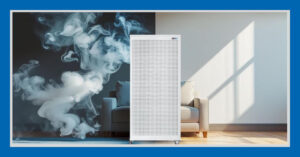
Thailand’s Air Pollution: Causes, Effects, Solutions
by Mark Simmerman / January 16, 2024
Air pollution in Thailand is a growing concern.
The country’s rapid industrialization and urbanization have led to increased emissions. Winds carrying air pollution from other Asian countries to Thailand worsen the problem.
Today, Thailand ranks consistently amongst the most polluted countries in the world.
What are the causes of Thailand’s air pollution problem?
How does it affect the population’s health and economy?
What can we do to protect ourselves from air pollution and fight the issue?
This article seeks reasons and answers
The Causes of Air Pollution in Thailand
Thailand suffers from air pollution for several months every year and is among the most polluted countries in the world.
This is surprising for a country known for its sunshine, beaches, and forests and causes some people to ask why.
There are many causes, but some are much more important than others, and the main causes vary by region and location.
In Thailand, after the rainy season ends in October, many people choose to gather and burn fallen leaves and other organic matter around their homes and businesses.
This heavy smoke pollutes the air in villages and cities for a few weeks every year. In northern and central Thailand from November through February, the burning of millions of rai of rice, maize corn, and sugar cane fields is the major cause of air pollution.
Farmers and agricultural corporations believe that burning crop residue is the easiest way to prepare their fields for the next planting season.
Finally, in northern Thailand forests from late January through April, villagers burn dried fallen leaves and bushes on the forest floor to make it easier to find mushrooms, pak wan (sweet leaves), and other forest products when the rains return.
Often, agricultural fires become out of control and extend into the forests.
In larger cities like Bangkok, air pollution comes from many sources, including automobiles and motorcycles, heavy industry, fossil fuel power plants, construction, and smoke from agricultural burning in surrounding areas.
Together, these behaviors cause us to breathe dangerously polluted air for several months every year.
What is Air Pollution?
Air pollution consists of particulate matter (PM) and gasses; the mixture varies depending on what is being burnt and at what temperature, and climatological factors such as temperature and wind speed.
Particulate Matter (PM)
The particles are the remains of carbon-based fuels such as crop waste, dry leaves, wood, coal, or petroleum.
These come in different sizes, but all are extremely small and measured in microns; usually divided into PM 2.5 and PM 10.
The World Health Organization Air Quality guidelines indicate that the average annual exposure to PM2.5 should not exceed 5 micrograms per cubic meter (μg/m3).
Most cities and regions in Thailand are far beyond reaching this standard. Bangkok’s PM2.5 air quality averaged 23.3 micrograms in 2022. This means it exceeded the recommended safe level by almost five times.
Unfortunately, there is no global standard for PM2.5 safe levels. In stark contrast, Thailand’s Pollution Control Department has set the ‘safe’ exposure limit at 50 μg/m3 and will lower this to 37.5 μg/m3 on June 1, 2023.
Despite this large difference, it is clear that the lowest possible exposure is best.
What Are the Health Effects of Air Pollution?
At higher concentrations, these particles become visible to the naked eye (sometimes called ‘haze’) but are harmful to us long before we can see evidence of air pollution in the sky.
The most dangerous particles include dioxins and aromatic hydrocarbons that lead to cell mutations and cancers. Because these particles are very small, they pass through our lungs and enter our bloodstream, where they harm our liver, kidneys, and immune system.
In response to these foreign toxins and oxidative stress, our immune systems mount an inflammatory response that makes heart attacks, strokes, headaches, fatigue, and infections more likely.
Lung diseases, pneumonia, and heart attacks
Lung cancer, pneumonia, chronic lung disease, and heart attacks are the leading causes of death from air pollution. According to the World Health Organization (WHO), air pollution causes about 7 million deaths worldwide each year.
The Global Burden of Diseases study estimated that in 2015, air pollution accounted for 19% of all cardiovascular deaths, 21% of deaths from stroke, and 24% of deaths from ischaemic heart disease.
29,000 premature deaths in Thailand
Because air pollution is more severe in Thailand, the proportion of cardiovascular death, stroke, and heart disease is likely to be even greater here.
It has been estimated that long-term exposure to PM 2.5 in Thailand contributed to 29,000 premature deaths in 2021. Had the PM 2.5 concentrations met the WHO standards, 22,000 lives would have been saved in that year alone.
Some of these illnesses are caused by short-term intense exposure to high pollution levels, whereas others come as an effect of long-term exposure to lower levels of air pollution.
How Air Pollution Affects Children and Pregnant Women
Exposure to air pollution has serious and lasting effects on infants, children, and pregnant women. Micrometer-sized particles pass directly through the placenta and harm the growing fetus.
The harmful effects of exposure to air pollution during pregnancy include increased infant mortality, lower birth weight, impaired lung development, impaired brain development, increased respiratory disease, and delayed development of the baby’s immune system.
Exposure to air pollution during pregnancy and childhood causes changes in the structure and function of the developing brain, negatively impacting the child’s ability to learn and remember.
Exposure to air pollution has also been associated with the development of attention deficit hyperactivity disorder (ADHD) and autism.
Even in adults, long-term exposure to air pollution decreases cognitive performance in verbal and maths tests. It is important to understand that the health effects of air pollution accumulate over time.
Every day that we breathe polluted air increases the chances of suffering serious long-term health consequences and shortens our lives. It is also crucial to understand that everyone is affected by air pollution.
Although some people experience more allergic-type responses (itchy eyes, sore throat, running nose) than others, all of us are harmed by air pollution.
The Effects on the Environment
The most common gases in air pollution are nitrogen dioxide (NO2), sulfur dioxide (SO2), ozone (O3), and carbon dioxide (CO2).
These gases directly contribute to global warming and the rapidly changing climate of the Earth.
At higher concentrations, these gases can have negative effects on our bodies, causing problems with our circulatory system and low oxygen levels (hypoxia) that cause fatigue, headaches, ‘brain fog’, nausea, and poor sleep quality.
When sulfur dioxide and nitrogen dioxide enter the atmosphere from burning and are transported by wind currents, these gases react with water, oxygen, and other chemicals to form sulfuric and nitric acids.
These acids mix with water and other materials before falling to the ground in what is commonly called ‘acid rain’.
The effects of acid rain are most obvious in streams, lakes, and marshes where it is harmful to fish and other wildlife. The more acid that is introduced into the ecosystem, the worse the effects.
Many types of plants, insects, fish, and amphibians cannot tolerate acidic waters and will die. Generally, the young are more sensitive than adults. For example, at pH 5, most fish eggs cannot hatch, and, at lower pH levels, adult fish die.
Indoor versus Outdoor Air Pollution
Clearly, it is important to do our best to reduce our exposure to air pollution. But how can we do this?
First, we need to understand that our indoor air at home is often as polluted, or even more polluted, than outdoor air.
The same is true for public spaces such as shopping malls, cinemas, and restaurants. Just because the air feels cool and you do not see any smoke does not mean that the air is clean!
Open doors, leaky windows, and filtration systems with fresh air intake may heavily contribute to indoor fine dust pollution.
Other sources can come from building materials. Asbestos, lead, and formaldehyde are common indoor air pollutants that can be released from insulation, flooring, and paint. E
Even furniture such as carpets or sofas can emit chemicals that lead to unhealthy air in your own home.
How To Protect Yourself From Dirty Air
Clearly, it is important to do our best to reduce our exposure to air pollution. But how can we do this?
First, we need to understand that our indoor air at home is often as polluted, or even more polluted, than outdoor air. T
he same is true for public spaces such as shopping malls, cinemas, and restaurants. Just because the air feels cool and you do not see any smoke does not mean that the air is clean!
Protection from Outdoor Air Pollution
Protection From Indoor Air Pollution
Reducing Air Pollution in Thailand: How Can You Help?
For the health of its people and our environment, Thailand must improve its air quality. We, as citizens and residents, can help.
Take the time to express your concerns to local, regional, and national political leaders. Until they understand that reducing air pollution is a top priority for all of us, it is unlikely that meaningful action will be taken.
Consider lending your support to Right to Clean Air Thailand and other groups working on this issue. The establishment of a national Clean Air Act is essential to reduce air pollution. Demand that ‘no burn’ agricultural policies and practices are implemented and that forest conservation laws are enforced.
If you own a home or farm, do not burn organic matter, but instead, use a natural compost system. Work to support clean energy alternatives and to end the burning of fossil fuels.
Use public transportation, walk, or bike whenever possible. If you have a car, make sure that its engine is in good condition and have tailpipe emissions are checked annually.
Make sure your school, daycare, and workplaces take air pollution seriously. Finally, talk to your friends, neighbors, and colleagues about air pollution. Each of us can play an important role in raising public awareness.
Bottom Line
Air pollution in Thailand is a significant and worsening issue, primarily due to agricultural burning, industrial emissions, and urbanization. The problem has dire consequences for public health, causing a range of illnesses and premature deaths, and also affects the environment through acid rain and climate change. Action, from individual behavioral changes to national policies, is urgently needed to mitigate the effects.
FAQ’s

Mark Simmerman
Mark Simmerman is a seasoned Public Health Epidemiologist with a career spanning over 25 years. He has the distinction of having worked for prestigious organizations such as the U.S. Centers for Disease Control and Prevention (CDC) and the World Health Organization (WHO).






